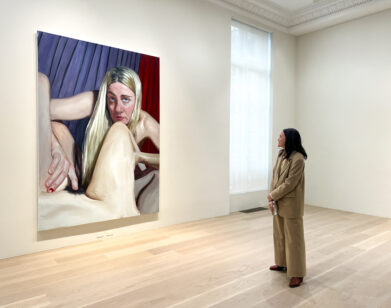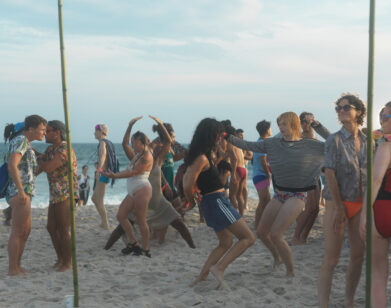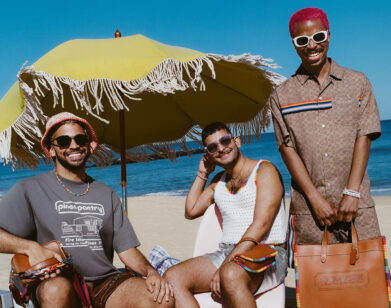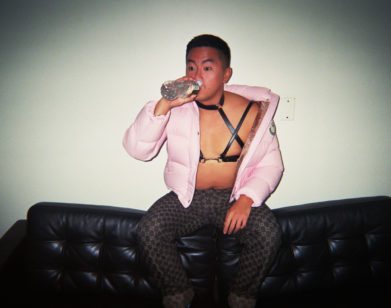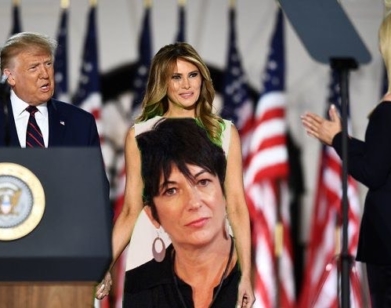IN CONVERSATION
Robin F. Williams and Jenna Gribbon on Cults, Motherhood, and Queer-Coded Horror
“We really went there,” Robin F. Williams proclaims about a wild vacation to Fire Island she took with friend and fellow painter Jenna Gribbon. The same can also be said about William’s latest exhibition at P.P.O.W. Gallery, Good Mourning, in which the artist’s cinephilia is on full display. A series of oil paintings that reference iconic horror films like Carrie and Texas Chainsaw Massacre, Williams’s latest show toys with ideas of gender, sexuality, the body, and transformation. “My theory is that superhero movies and horror movies are mirrors of each other, or two sides of the same coin,” Williams told Gribbon last month in the Pines, shortly after wrapping another recent exhibition at the Columbus Museum of Art and just before Gribbon opens Like Looking in a Mirror at David Kordansky. “Superhero movies feel like confirmation bias and horror movies feel like the counterpoint.” In conversation, the two Brooklynites discussed cults, queer-coded horror, and the relationship between motherhood and artmaking.—ARY RUSSELL
———
WILLIAMS: Jenna was just telling me about her family history. We’re talking about her mom.
GRIBBON: Yeah, I was raised Mormon. My mom converted when I was five years old, but she had previously been a Scientologist in her late teens. She was on one of those Sea Org boats, and as I understand it, she escaped from it when the boat pulled into the port to refuel, and she went back to Tennessee and she met my dad. I was told that my dad lit her cigarette with a match on the bottom of his boot, and she was immediately taken.
WILLIAMS: So romantic. I want to watch a biopic about your mom.
GRIBBON: They got together and got divorced when I was two and a half. My mom was single and 24 years old at this point with two kids under the age of five. She moved to Georgia and she met some Mormon man who convinced her to go to church. She later found out that he was married, but she had already converted at that point. My mom just was like, “How am I going to raise these two little kids by myself?” But the Mormon Church is very community oriented and very supportive. If you need help, you can get it or financially, or if you’re moving, everyone will show up and move your whole house for you.
WILLIAMS: Right.
GRIBBON: Anyway, what were we originally talking about?
WILLIAMS: I don’t know. I just kept asking you questions about your mom and her story just kept getting more and more fascinating—
GRIBBON: Oh, we were talking about Oprah. My whole adolescence, I was trying to explain to my family that it [Mormonism] was all bullshit. I was 15, 16 when things started to come in focus, and I started trying to get them to question things, and they weren’t really willing to. It was very divisive and contentious, and we fought constantly. Then Oprah had a book in her book club that was basically debunking Mormonism. My mom read it, and was like, “Jenna, I realized it’s all not true.” She is so much more laid back now. She was a square peg trying to fit into this role of the Mormon woman, but she was never that person. She’s much happier now.

I Spit on Your Grave 2, 2022. Pastel and colored pencil on paper. Sheet: 10 7/8 x 15 ins. (27.6 x 38.1 cm).
WILLIAMS: It’s crazy how many major shifts in her worldview she went through.
GRIBBON: Now her motto is, ‘It is.’ She refuses to get bent up about what anyone else is saying or doing, she’s just pure acceptance.
WILLIAMS: I wonder if she always had that in her, and Oprah just gave her permission to finally be that way fully.
GRIBBON: She had the potential, but she was fighting for her survival. I can’t really imagine being that age—that young, mid-twenties—and trying to raise two young children by myself. So where did your interest in cults come from?
WILLIAMS: Well, from a psychological standpoint, I’m interested in how we become vulnerable to groupthink, or to coercive personalities. Most people think of themselves as someone who would never join a cult or get scammed. But the more I looked into it or examined my own experiences, I realized how easy it actually is. In my research, there was a big emphasis on the fact that there’s no demographic profile of who is susceptible. You can be rich, poor, whatever gender, race, religion, it doesn’t matter. If you’re vulnerable, if you’re looking for meaning, if you’re going through a transition, you’re susceptible. Also, I think what keeps people under control is that they don’t want to believe that it’s true. They can’t accept that something has power over them, and that extends into addiction. So I have personal reasons for being interested, and it’s something I could dissect at every scale.
GRIBBON: I mean, we see it all around us.
WILLIAMS: Absolutely.
GRIBBON: We’re being sorted into our cult bubbles of right and left, and it’s like, “These are the tenets that we all subscribe to and this is how we behave and how we think.”
WILLIAMS: Yeah, it sneaks up on you.
GRIBBON: Because of my allergy to groupthink from my upbringing, I feel like I try to constantly think about what I really believe in, not just what’s being fed to us. But I mean, I’m not immune to it.
WILLIAMS: That’s the thing, none of us are. I think that’s why I’m attracted to horror genres. There’s a tipping point where you’re not in a horror story, but then suddenly you are. We think that we’re in control of our consciousness and the way that we’re moving through our world, but then suddenly you wake up and realize you’re in a bubble. You’re in a way of thinking that you didn’t even know was trapping you. There are no heroes in horror; it’s about the shadow side of things. It’s important to look at that mindset where you think you are on the right side of something. My theory is that superhero movies and horror movies are mirrors of each other, or two sides of the same coin. Superhero movies feel like confirmation bias and horror movies feel like the counterpoint.
GRIBBON: Yeah. Thinking back to the way that you were describing your high school experience, it’s like the perfect setup for a horror scenario.
WILLIAMS: Oh, my God. I love high school horror. That’s its own genre.
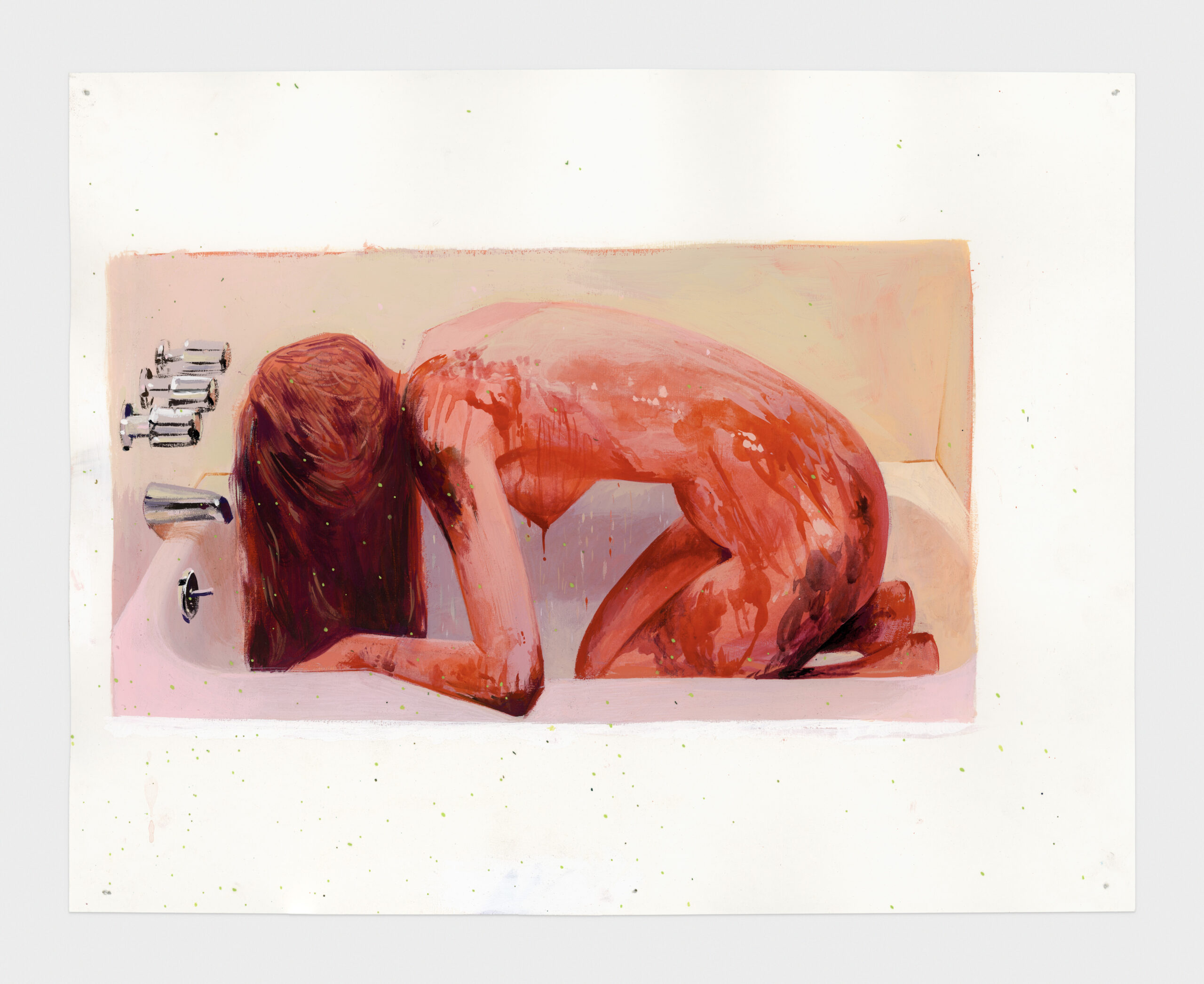
I Spit on Your Grave 1, 2023. Gouache on paper sheet: 11 x 14 ins. (27.9 x 35.6 cm)
GRIBBON: It’s the thing that disrupts the groupthink. In that scenario, everyone’s playing along with expectations, conforming to who they’re supposed to be, and then the horror scenario comes along to take away the safety in that.
WILLIAMS: Yeah. I’m also attracted to it because it has so much queer subtext. There’s so many queer coded characters, especially in the era that I grew up in, like The Faculty. I don’t know if you saw that one.
GRIBBON: No.
WILLIAMS: I don’t know if anyone saw it. It had a lot of big teen stars at the time, like Josh Hartnett.
GRIBBON: I’m more from The Blair Witch-era.
WILLIAMS: That was the movie I saw on my first date. But yeah, there’s always these conventions about sexuality and promiscuity, and the lead character tends to be this queer-coded lesbian or gender-ambiguous person that’s interested in the conspiracy more than they’re interested in heteronormative sex.
GRIBBON: Right.
WILLIAMS: I love that subtext, and it’s very validating. It gives you the permission to point at the thing that no one’s talking about. It’s a way to talk about a lot of overlapping themes that I care about and a felt sense of an experience, which I also think is what all your work is about: An embodied experience of what’s real, as opposed to a facade.
GRIBBON: And what’s real as opposed to what people project onto your reality. I’m trying to parse out what’s actually mine. What am I feeling? What’s my experience? This particular body of work is very much trying to describe something that is really psychedelic and felt. I still don’t even know how to put it into words, but hopefully it’s legible in these paintings, this very psychedelic, felt experience of the uncanny aspect of parenthood.
WILLIAMS: Right. I’m painting about horror and you are painting about parenthood. We’re not trying to draw a direct line…
GRIBBON: It’s us trying to understand our personal experience in both cases and both being drawn to things that are narrative and tableaux in some way. My son is 13 and he’s starting to look just slightly less like a child. He’s not fully masculinized yet hormonally, he’s in this ambiguous state where he probably looks more like me now than he ever will. He’s a little bit of my doppelgänger. Speaking of horror, a doppelgänger is something that’s usually met with fear and disgust. Nobody wants to meet their doppelgänger, but it’s so bizarre when it’s your child because there’s so much love and empathy. And so it does this other strange thing where you’re like, “You are not me, but you’re reflecting so much back to me about myself, but I’m able to meet those aspects of myself with so much more empathy because I love my child more than anything.” You’re just so much more loving and accepting when you see these things in your child and you’re like, “Well, maybe I’m not so bad after all.” There’s an aspect of parenthood that is all wrapped up in mirroring and projecting and replicating experiences that you had, and you’re sort of downloading these experiences into your child.”
WILLIAMS: And there’s something about the passing down aspect of it.
GRIBBON: Yeah, it is a strange, uncanny, psychedelic replication thing where not only do you look like me, but I’m going to download all my experiences into you. I just wanted to make paintings about this particular moment in time because it really feels fleeting and incredibly psychedelic. And also expansive, and such a period of growth for both of us.
WILLIAMS: Yeah.
GRIBBON: I learned so much about myself by seeing aspects of myself develop in him, because I’m reminded of the way that certain things originated in me, where they came from, what age they appeared, and the direction they took. It’ll be interesting to see how those things play out in him, because he’s living a totally different life, having a totally different experience. And this also brings me back to our conversations about the multiverse.
WILLIAMS: We got really trippy on this vacation.
GRIBBON: Yeah. We were on Fire Island.
WILLIAMS: We really went there.
GRIBBON: But obviously he’s not me, but he is of me physically. He grew in my body, and I fed him from my body. It was a long process of physically separating from him, and yet he sort of mirrors me back to myself more than ever. I am watching these things play out that I recognize in myself, but they’re playing out in such different ways. This is the first time I’ve made a whole show about him. Me making paintings about people that are close to me is about peeling back what I think that I know, and trying to really see and re-see in every moment.
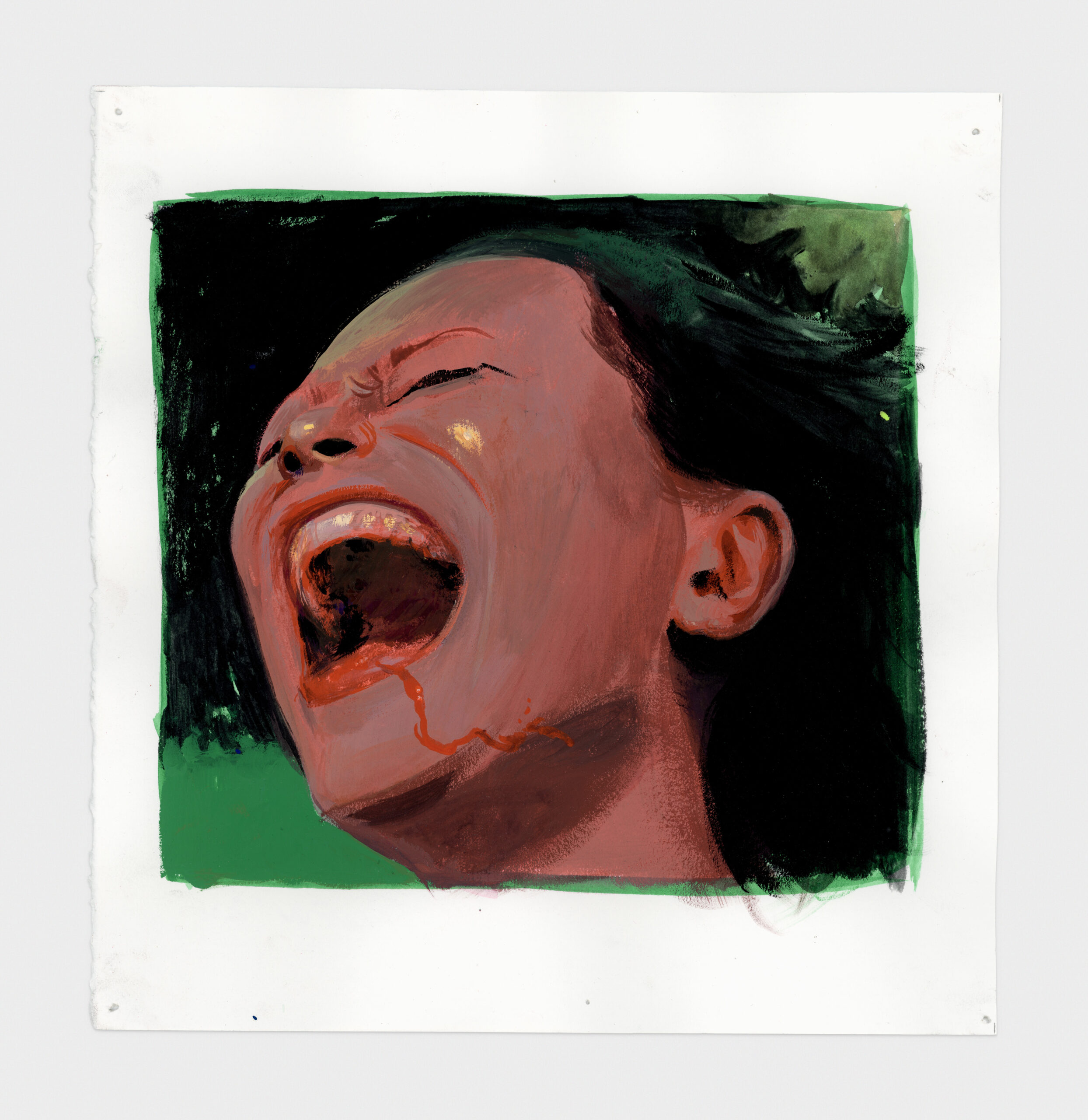
Ganja & Hess 1, 2023. Gouache on paper sheet: 10 x 9 5/8 ins. (25.4 x 24.4 cm).
WILLIAMS: That’s so beautiful. I’m not a parent, so I want to ask you if these things feel related. Mothers as artists is this really unexplored terrain historically, but it’s such a poignant metaphor and it feels like there’s so much overlap between being a mother and being an artist.
GRIBBON: Definitely. Art making is a kind of parenthood—you are kind of parenting your work in a way and there is the same kind of complicated ego relationship. In some ways, it’s even harder for people like us, because for both of us, we had a long period of time where people weren’t paying attention to what we were doing. We met about a decade ago, and we were both super frustrated. We were making all these paintings and no one cared, which is fine now, but when you’re making paintings and people are now paying attention, it becomes harder and harder to not let your ego have an outsized role. Ten years ago, if we wanted to make a really weird painting that we didn’t think anyone was going to like, we would’ve been more likely to make it.
WILLIAMS: Yeah, no fear.
GRIBBON: And that’s a hard reality to accept. I don’t want to believe that about myself. But, if we’re going to put it in psychological terms, there’s the painter superego stepping in and being like, “Let’s not do that.” Whereas when nobody’s paying attention, your painter id is like, “Fuck it, I’m going to make a toenail painting.”
WILLIAMS: Yeah, that’s so true. You put it so beautifully about the healthy detachment from your mirror self in your child. I think in being a creative person, you really let them become who they are in spite of the fact that you see so much of yourself in them, and that part of your ego wants to claim them. When I was painting about children, they were these faux portraits of children that were about the shadow side of that. That ego, that impulse to want to have a second shot at something through a child, or to live vicariously through a child or claim a child as part of themselves.
GRIBBON: That’s a very common pitfall for parents, especially parents who are unhappy with the path that they’ve chosen. What they think is, “My kid is now what’s important, and the dreams that I had are no longer important.” But then those dead dreams come back in a horror movie.
WILLIAMS: Yes, resurrected like a ghost.
GRIBBON: They pop back up because they never really died, and they come back as zombie dreams that try to pull on the children. Maybe that’s dramatic.
WILLIAMS: I mean, when I was making those paintings, I was referencing Dutch golden age portraiture of child monarchs, or this impulse to have a child’s likeness immortalized for the purpose of preserving an empire. The superego of all the super egos.
GRIBBON: Exactly.
WILLIAMS: I love the counterpoint of that being the recognition that this impulse exists in us, and then the letting go of that control. Then I think about the way that you made these paintings so collaboratively as opposed to being so procedural. You guys had a real back-and-forth about composing them, right?
GRIBBON: Yeah. My main struggle as a child myself was feeling like I had no agency and I was really controlled at every turn. So for me, it’s supremely important that my child feels like he has a sense of agency and his sense of self and his own instincts about himself are validated. In any kind of representation of him, I want his approval. Half the paintings in the show are built around a photo that he took of me. We projected it on the wall, and he’s standing in front of the photo in front of the projection, or sometimes I’m projected onto his face. I don’t know how that gets back to what your point was.
WILLIAMS: That you weren’t just art-directing every scene.
GRIBBON: I’m not trying to, even though I literally superimposed myself. I guess it ends up being more about my experience because we’re all trapped in our experience.
WILLIAMS: And you’re the artist.
GRIBBON: Yes. It’s from my perspective of what this moment in parenthood feels like, but he is obviously a co-creator of our reality. So in order for the paintings to feel authentic, he would have to co-create them with me.
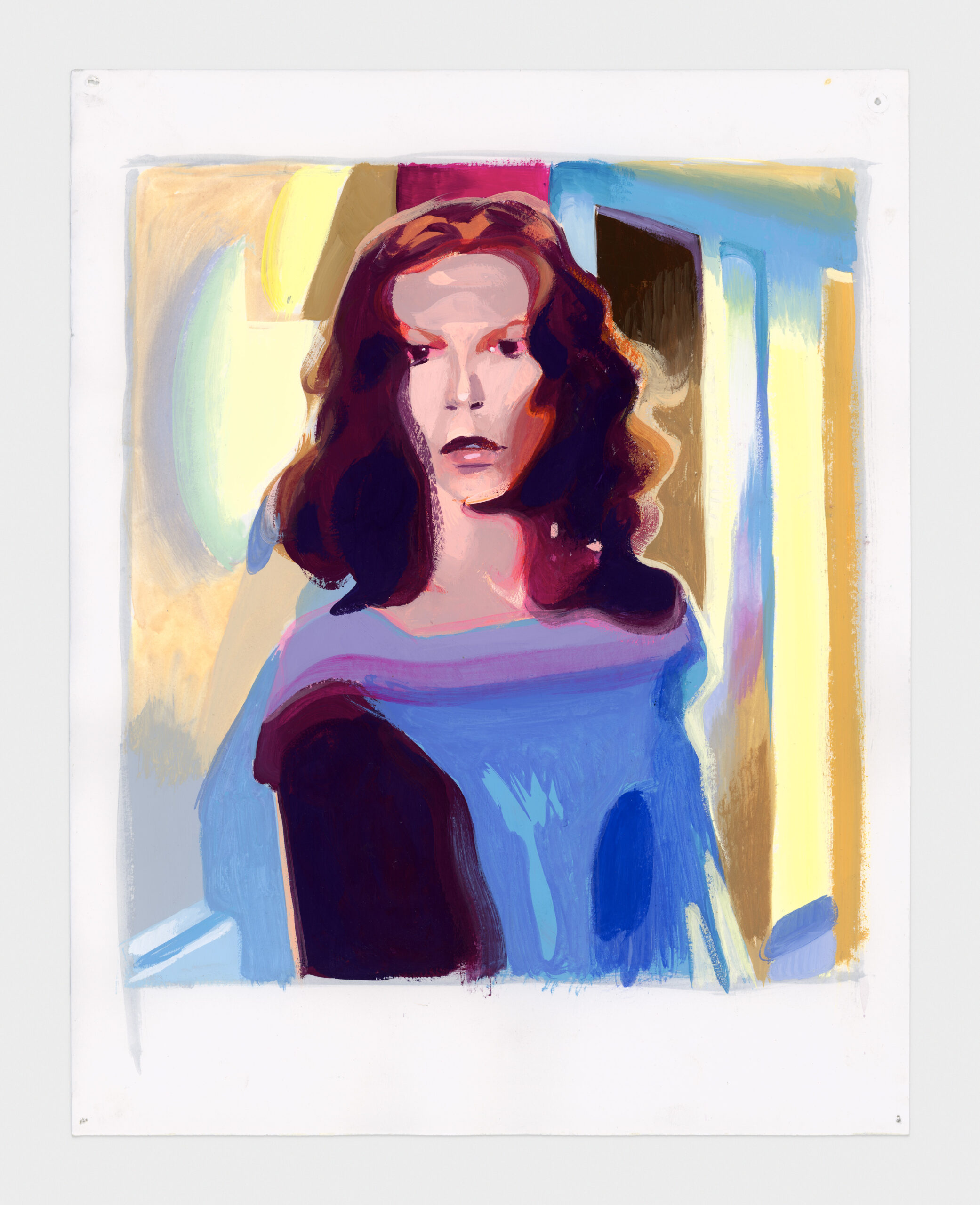
Halloween II, 2023. Gouache on paper sheet: 14 x 11 ins. (35.6 x 27.9 cm).
WILLIAMS: Yeah, or else he would just become a prop. This is how I feel about my work in general, that you can boil it down to a personal experience. Parts of it are experiences that I can claim, but I think my interest is also overlapping with something larger that I’m witnessing. It may be about feelings that I was picking up as a child, and also this phenomenon that I was observing about the way we organize children in our society. They’re an identity group that gets objectified or exploited, so I was coming at it from that angle. So it’s nice to see you painting about it in this way. You’re reckoning as an individual with the counterpoint to that: How do I want to co-create a future as a parent with my child?
GRIBBON: But I still have to grapple with the sort of nefarious aspects of that in the way that as the parent. I have to make sure that he’s not objectified in these paintings, which is a tricky thing to do. My way of doing that is I almost never paint myself. But in these paintings it was like, “Well, if my child is going to be in these paintings, I have to be a big presence in these paintings.” I’m this stern guardian. It’s like, “If you’re going to consume an image of my child, I’m watching you.”
WILLIAMS: I’m watching you.
GRIBBON: Yeah, I am ever-present, looming large, and we are here together. As a parent, you do have to attempt to wrap your head around being on both sides. You can’t just have your own experience and abandon responsibility to what your child’s experiencing.
WILLIAMS: It makes me think about this very difficult tightrope that mothers are asked to walk, where there’s an expectation that they’re meant to sacrifice everything for their child and be invisible. It’s so beautiful to see you do a two-for-one. You’re willing to be vulnerable but protective, and then also take up space as a mother instead of diminishing yourself.
GRIBBON: That’s true. Mothers get the short end of the stick. Mothers are expected to sublimate themselves, and these paintings are a refusal of that. I like the idea that people are very aware of this romantic or sexual aspect of my life, but my role as a mother is just as important. Somehow it’s 2024, and people still don’t understand that those things coexist.
WILLIAMS: And as an artist.
GRIBBON: And as an artist, and a professional person, and a community member. It’s important to see representation of someone who can really foreground motherhood and still have all of those other things be hugely important and powerful. It’s like the focus shifts from hour to hour, but they’re all always there. It’s important to bust open these archetypal boxes that we’ve decided that we’ve never been able to.

Texas Chainsaw Massacre, 2022. Pastel and colored pencil on paper sheet 15 x 18 7/8 ins. (38.1 x 47.9 cm).
WILLIAMS: Yeah. I was thinking about what’s necessary for systems of control is this black and white thinking. Those roles get extremely defined in really narrow terms. If you’re a mother, you’re not sexual. If you’re a child, then you’re obedient, and making art that explodes or undermines whatever recipe makes those black and white concepts feel real and compelling. That’s important to me because paintings are this document on the wall. I love that about painting because it’s nonverbal in that way. As we do this interview, you don’t have to defend it in words. It’s a visual document that makes nuance a physical fact on the wall, in a way.
GRIBBON: Yeah. Both of our shows are trying to complicate these preconceived notions of the experiences that other people are expecting us to have. We’ve probably gone way over time.
WILLIAMS: We’ve exceeded our time.
GRIBBON: I know.
WILLIAMS: Do you feel good?
GRIBBON: I feel good.
WILLIAMS: Okay, bye.


